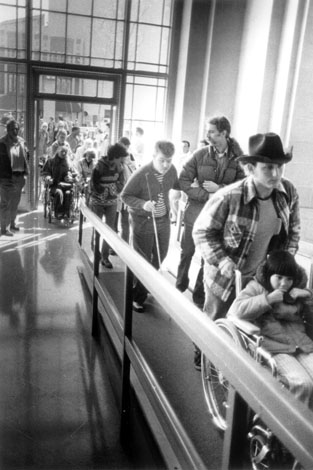Celebrating 20 Years of the Americans with Disabilities Act
The other night I saw a public service announcement on television in which President Obama marks the 20th anniversary of the Americans with Disabilities Act. Â My first reaction was, wow, 20 years already! Â My second reaction was to reflect on the efforts of ordinary people to effect such a profound change in the American landscape and society.
The disability rights movement fits squarely within the broader context of the civil rights movement of the 1960s and 1970s. Â Activists borrowed demonstration tactics and the language of the black freedom struggle and the women’s movement. Â (One of my favorite images in the Smithsonian’s online exhibit about the disability rights movements is of a “black power” fist superimposed with “wheelchair access” icon.)* Â In the 1989 photograph below, the demonstrator has outfitted with his wheelchair with a protest sign that reads “I can’t even get to the back of the bus”, cleverly referencing earlier struggles to end segregation.
The first recognition of the legal rights of people with disabilities came with the federal Rehabilitation Act of 1973. Â The act stated that no institution could receive federal aid if it discriminated against the disabled. Â The law shifted the burden of access from the disabled person to the institution; in other words, employers, building owners and educators had to accommodate everyone, rather than relying on individuals’ determination to find a way into the building or ways to participate in the work or school environments.
I think all the time I was growing up and afterwards there were a lot of buildings I could not get into or had to have people to carry me into them. Â I really feel, particularly in public buildings, that we have the right to go into any room we want. Â When I know I can’t go into the bathroom I get pretty nervous about it… Â Imagine having two male guards have to carry you to the bathroom. Â Most women would be appalled.
I went to college where they had some steps and they weren’t interested in putting in a ramp because I was the only disabled student and it wasn’t aesthetically pleasing.  I was the first person in a wheelchair and when I went I had to sign a  paper saying I would be responsible for my own mobility.
(Maryellen O’Grady, Testimony before Congress, 15 April 1977)
However, as with other civil rights battles, only the continued activism of people with disabilities and their allies forced institutional changes. Â Not unlike the lag time between Brown vs. Board of Education and the actual desegregation of schools, the Department of Health, Education and Welfare failed to publish regulations for accommodations or to punish institutions that refused to comply with the new law. The meaning and implementation of the Rehabilitation Act was thus worked out over time, as activists staged sit-ins, pressed charges, and testified before Congress about the slow pace of change and denials of their constitutional rights.
I can tell you that every time you raise issues of separate-but -equal the outrage of disabled individuals across the country is going to continue, is going to be ignited. Â There will be more takeovers of buildings until finally, maybe, you’ll begin to understand our position. Â We will no longer allow the government to oppress disabled individuals. Â We want the law enforced. Â We want no more segregation. Â We will accept no more discussions of segregation and I would appreciate it if you would stop shaking your head in agreement when I do not think you know what we are talking about.”
(Judy Heumann, Testimony before Congress, 15 April 1977)

Demonstrators enter San Francisco's regional headquarters of the Department of Health, Education and Welfare for a 1977 sit-in to protest the government's failure to publish regulations for accommodations or to punish institutions that refused to comply with the Section 504 Rehabilitation Act of 1973.
Seventeen years after the Rehabilitation Act, the ADA and the Individuals with Disabilities Education Act (IDEA) more explicitly spelled out the types of accommodations that would protect disabled people’s rights. The laws expand the provisions of the 1973 act to include private businesses and public education.
These laws have profoundly transformed the physical and social landscape. Â Rand Paul’s rants aside, most Americans accept the basic premise that the government, private businesses and educational institutions should provide access to everyone. Â And everyone has benefitted as architects and educators have implemented Universal Design principles: women with strollers or travelers with wheeled luggage benefit from ramps at the curb; tired folks and people with temporary injuries appreciate elevators; anyone can follow closed captioning in otherwise noisy spaces; all students, even those without diagnosed learning disabilities, learn from differentiated instruction.
It is also worth reading the personal stories that people have shared on the government’s website commemorating the 20th anniversary of the ADA and IDEA. Â There people have described the impact of the laws in their own lives, as well as the work that still needs to be done to ensure equal access for everyone.
*Visitors to the Smithsonian’s site will notice some of the accommodations that have been made for different types of disabilities. Â For instance, each object on the site includes a text description; this allows computers with read-aloud software to describe the image to the visually impaired.
Last 5 posts by Leah Nahmias
- Teaching "What This Cruel War Was Over" - March 28th, 2011
- State of Siege and Public Memory at Ole Miss - March 25th, 2011



